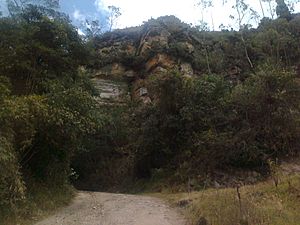Viracachá facts for kids
Quick facts for kids
Viracachá
|
||
|---|---|---|
|
Municipality and town
|
||

Ancient road used by the Muisca in Viracachá
|
||
|
||

Location of the municipality and town of Viracachá in the Boyacá Department of Colombia
|
||
| Country | ||
| Department | Boyacá Department | |
| Province | Márquez Province | |
| Founded | 15 February 1556 | |
| Area | ||
| • Municipality and town | 68 km2 (26 sq mi) | |
| • Urban | 1 km2 (0.4 sq mi) | |
| Elevation | 2,520 m (8,270 ft) | |
| Population
(2015)
|
||
| • Municipality and town | 3,222 | |
| • Density | 47.4/km2 (122.7/sq mi) | |
| • Urban | 374 | |
| Time zone | UTC-5 (Colombia Standard Time) | |
| Website | Official website: http://www.viracacha-boyaca.gov.co/ | |
Viracachá is a small town and a municipality in Colombia. It is located in the Boyacá region, specifically in the Márquez Province.
Viracachá sits high up on a plateau called the Altiplano Cundiboyacense. This area is about 22 kilometers (14 miles) from Tunja, which is the capital city of the Boyacá department. The main town area is 2,520 meters (8,270 feet) above sea level. Some parts of Viracachá are even higher, reaching up to 3,200 meters (10,500 feet).
The municipality shares its borders with several other towns. To the north and east, it borders Siachoque, Rondón, and Soracá. To the south, it borders Ciénega. To the west, it borders Ciénega, Soracá, and Ramiriquí.
Contents
What Does the Name Viracachá Mean?
The name Viracachá has a few possible meanings. One idea is that it comes from the Quechua language. In Quechua, it might mean "air of the lake."
Another idea is that the name comes from the Chibcha language. In Chibcha, it could mean "lord of the enclosure of the wind."
A Look Back: The History of Viracachá
Long before the Spanish arrived, the area of Viracachá was home to the Muisca. The Muisca were a group of people who lived in what is now Colombia. They had a loose group of communities called the Muisca Confederation.
Because Viracachá was close to the Muisca's northern capital, Hunza, it was ruled by a leader called the zaque.
Modern Viracachá was officially started by Dominican missionaries on February 15, 1556.
How People Make a Living in Viracachá
Viracachá is mostly a rural area. This means that most people live and work outside the main town center. Many people work in the service industry, helping others with various tasks.
Farming is also important here. People grow crops and raise chickens. It's a small community, and the town does not have its own bank.
Images for kids
See Also
 In Spanish: Viracachá para niños
In Spanish: Viracachá para niños



